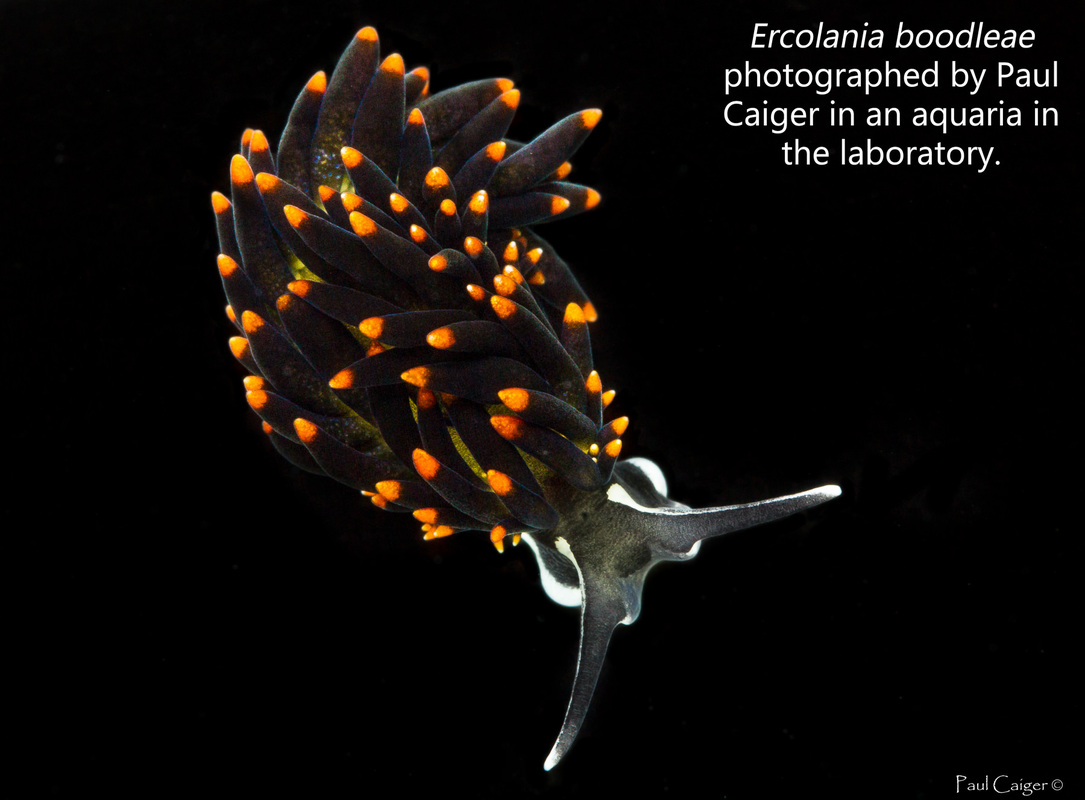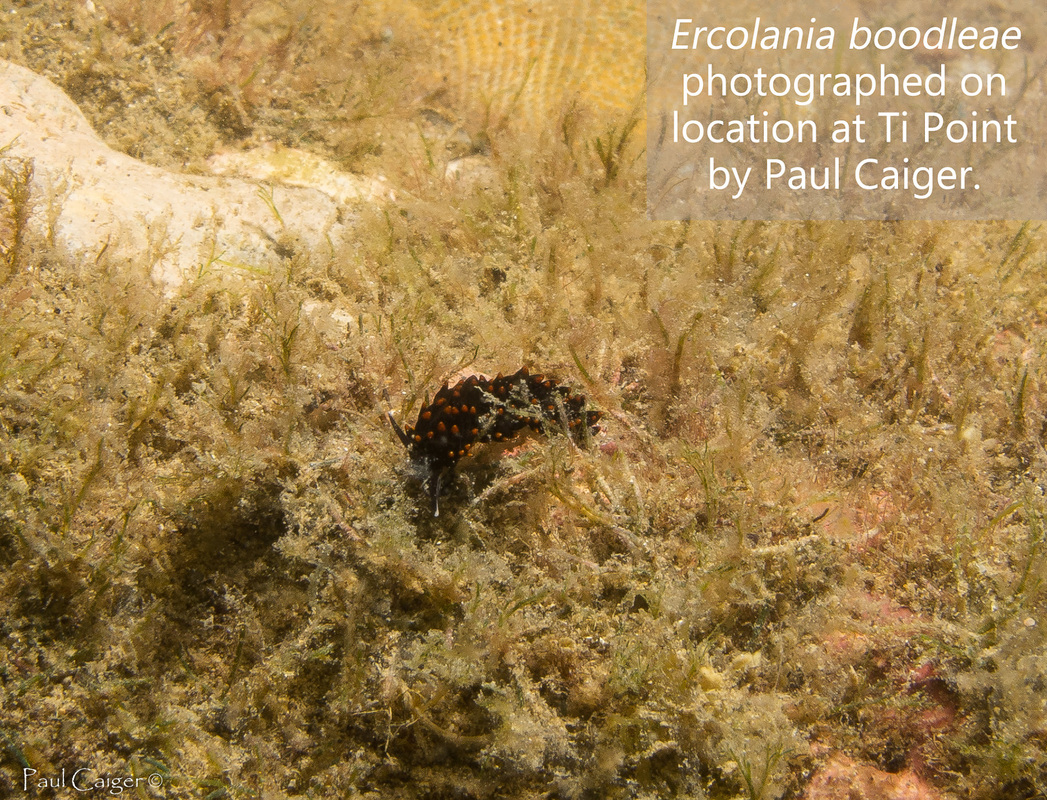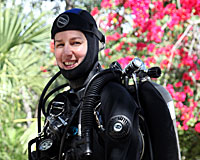Big things can start out in small ways. The email read, “I was out diving yesterday”. Just like that a train of messages kicked off and before I had finished reading I was jumping up and down with excitement – the latest mollusc to be found in New Zealand was a sap-sucking sea slug!
Paul Caiger was scuba diving near the mouth of Ti Point looking for triplefin nests back in November 2014. That might seem like an odd thing to be out doing, unless you’re a PhD student at the Leigh Marine Laboratory. Paul is researching evolutionary ecology in triplefins in the Hauraki Gulf.
A small black sea slug, 10-15 millimetres long, was crawling around on some turfing algae in the rocky shallows. It caught Paul’s eye, and he didn’t recognise it. Being the scientist that he is, he whipped out the trusty little collection bag kept on hand for just such an occasion and took a couple of specimens back to the lab to get some decent photos.
Paul had a sneaking suspicion he had stumbled upon Ercolania boodleae. Except that Ercolania boodleae had never been reported in New Zealand before. He emailed the mollusc expert Dr Richard Willan. Dr Willan is the Senior Curator of Molluscs at the Museum and Art Gallery of the Northern Territory in Australia. He’s also a kiwi and our go-to guy when we find new and unusual molluscs.
Dr Willan came back with the remarkable news, “you are absolutely right! It is Ercolania boodleae (Baba, 1938) (Sacoglossa: Limapontiidae) AND this is the first record for New Zealand…This is extremely exciting as it represents the most recent introduction of a mollusc to New Zealand”. Yeeeeeaaaaaaah baby!
As you’re reading this, you can’t see that I’m doing the dance that you do when you find out that a new sea slug has been discovered in your backyard. Sea slug lovers will know what I mean. Others may be left baffled by my excitement. What I can say is WELL DONE PAUL! This is a fantastic find.
Paul Caiger was scuba diving near the mouth of Ti Point looking for triplefin nests back in November 2014. That might seem like an odd thing to be out doing, unless you’re a PhD student at the Leigh Marine Laboratory. Paul is researching evolutionary ecology in triplefins in the Hauraki Gulf.
A small black sea slug, 10-15 millimetres long, was crawling around on some turfing algae in the rocky shallows. It caught Paul’s eye, and he didn’t recognise it. Being the scientist that he is, he whipped out the trusty little collection bag kept on hand for just such an occasion and took a couple of specimens back to the lab to get some decent photos.
Paul had a sneaking suspicion he had stumbled upon Ercolania boodleae. Except that Ercolania boodleae had never been reported in New Zealand before. He emailed the mollusc expert Dr Richard Willan. Dr Willan is the Senior Curator of Molluscs at the Museum and Art Gallery of the Northern Territory in Australia. He’s also a kiwi and our go-to guy when we find new and unusual molluscs.
Dr Willan came back with the remarkable news, “you are absolutely right! It is Ercolania boodleae (Baba, 1938) (Sacoglossa: Limapontiidae) AND this is the first record for New Zealand…This is extremely exciting as it represents the most recent introduction of a mollusc to New Zealand”. Yeeeeeaaaaaaah baby!
As you’re reading this, you can’t see that I’m doing the dance that you do when you find out that a new sea slug has been discovered in your backyard. Sea slug lovers will know what I mean. Others may be left baffled by my excitement. What I can say is WELL DONE PAUL! This is a fantastic find.
As it turns out, Ercolania boodleae, with its body covered in pencil-like cerata, is getting around. In 2014 it was reported from the central Gulf of California. Dr Willan posed an interesting question, “why should it spread globally when almost no other sacoglossan is doing the same (except for Stiliger aureomarginatus and Aplysiopsis formosa)?” We don’t have the answer.
We can’t say for sure if this is a very recent introduction to northern New Zealand. Dr Willan postulated, “If they had been spotted previously, it is likely they would have been misidentified as (a colour form) of Ercolania felina despite obvious differences in body form and habitat.”
Paul has the preserved specimens of Ercolania boodleae ready to be delivered to the Auckland Museum for their marine invertebrates collection. We are hoping that this new find will be included in the Checklist of New Zealand Molluscs.
Divers are encouraged to look out for Ercolania boodleae and report their findings so that we might get an idea of the population's density and size range. Please email [email protected] if you think you've spotted these sea slugs around New Zealand - photos appreciated!
Very special thanks to Paul Caiger and Dr Richard Willan for sharing this discovery with me.
All photographs copyright Paul Caiger.
Sacoglossan Snapshot
Name: Ercolania boodleae
Size: Approximately 10-15 mm.
Description: Upper body surface covered in black cerata with orange-brown caps, rhinophores are black and white.
Location: Found at a depth of about 4 metres at Ti Point, near Whangateau in the upper North Island of New Zealand.
Record: 8 or 9 specimens - first New Zealand record. Known from Australia, Japan and the Gulf of California.
We can’t say for sure if this is a very recent introduction to northern New Zealand. Dr Willan postulated, “If they had been spotted previously, it is likely they would have been misidentified as (a colour form) of Ercolania felina despite obvious differences in body form and habitat.”
Paul has the preserved specimens of Ercolania boodleae ready to be delivered to the Auckland Museum for their marine invertebrates collection. We are hoping that this new find will be included in the Checklist of New Zealand Molluscs.
Divers are encouraged to look out for Ercolania boodleae and report their findings so that we might get an idea of the population's density and size range. Please email [email protected] if you think you've spotted these sea slugs around New Zealand - photos appreciated!
Very special thanks to Paul Caiger and Dr Richard Willan for sharing this discovery with me.
All photographs copyright Paul Caiger.
Sacoglossan Snapshot
Name: Ercolania boodleae
Size: Approximately 10-15 mm.
Description: Upper body surface covered in black cerata with orange-brown caps, rhinophores are black and white.
Location: Found at a depth of about 4 metres at Ti Point, near Whangateau in the upper North Island of New Zealand.
Record: 8 or 9 specimens - first New Zealand record. Known from Australia, Japan and the Gulf of California.
Breaking News - August 2015
Paul Caiger's discovery of Ercolania boodleae in New Zealand has been published in Sportdiving Magazine.
Willan, R.C., Perkins, A.J. & Caiger, P.E. (2015). Boodlea baffles biologists. Sportdiving Magazine 169: 74-76.
The article has been sent to Professor Hamish Spencer for incorporation into the Checklist of the Recent Mollusca Recorded from the New Zealand Exclusive Economic Zone (http://www.molluscs.otago.ac.nz).
The article has also been sent to Lisa Marie, Incursion Investigator with the Ministry for Primary Industries (MPI). MPI is interested in any new-to-New Zealand species - plant, animal or disease. They have staff on duty 24/7 for terrestrial and marine reports. If you ever find a new critter or witness a mass mortality event (e.g. fish stranding), phone MPI on 0800 80 99 66. MPI are happy to check things out and have laboratory facilities for investigating suspected diseases. We don't need any more pests in our marine space.
A risk assessment will be performed on Ercolania boodleae to determine if there is any threat to our environment. Many thanks to Lisa from the Surveillance and Incursion Investigation (Animals and Marine) Team, it's great to know they've got our back.
I'm thrilled that this story has had a happy ending. For a while it looked like finding a place to publish this discovery would allude us and we would have no official record. Dr Richard Willan has done a fantastic job writing up this discovery and securing publication in Sportdiving Magazine. Thank you Richard and Paul!
Willan, R.C., Perkins, A.J. & Caiger, P.E. (2015). Boodlea baffles biologists. Sportdiving Magazine 169: 74-76.
The article has been sent to Professor Hamish Spencer for incorporation into the Checklist of the Recent Mollusca Recorded from the New Zealand Exclusive Economic Zone (http://www.molluscs.otago.ac.nz).
The article has also been sent to Lisa Marie, Incursion Investigator with the Ministry for Primary Industries (MPI). MPI is interested in any new-to-New Zealand species - plant, animal or disease. They have staff on duty 24/7 for terrestrial and marine reports. If you ever find a new critter or witness a mass mortality event (e.g. fish stranding), phone MPI on 0800 80 99 66. MPI are happy to check things out and have laboratory facilities for investigating suspected diseases. We don't need any more pests in our marine space.
A risk assessment will be performed on Ercolania boodleae to determine if there is any threat to our environment. Many thanks to Lisa from the Surveillance and Incursion Investigation (Animals and Marine) Team, it's great to know they've got our back.
I'm thrilled that this story has had a happy ending. For a while it looked like finding a place to publish this discovery would allude us and we would have no official record. Dr Richard Willan has done a fantastic job writing up this discovery and securing publication in Sportdiving Magazine. Thank you Richard and Paul!




 RSS Feed
RSS Feed

